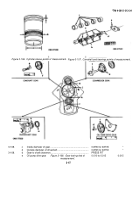TM-9-2815-213-34 - Page 89 of 192
*TM 9-2815-213-34
Also,
connect a manometer to the Blow-By
Tool
measure the amount of blow-by gases escaping past the
piston rings.
NOTE
This is essential to indicate seating of
rings and to ascertain if and when
additional run-in time is necessary.
3-170.
Preparation For Starting
As an assist in priming the fuel and lubricating oil s3-
stems it is recommended that all filter: removed and
serviced with their respective
a.
Prime fuel pump before starting engine the first
time.
Remove plug next to tachometer drive and fill with
clean diesel fuel.
b
. Check Fuel Tanks.
There must be an adequate
supply of good grade,
clean diesel fuel the tanks.
c.
Close all drain cocks and open vent cocks,
on
air compressor and vent (pipe plugs) water crossover
tubes to insure circulation.
d.
Fill engine with required coolants until it flows
from vent cocks and vents; close all vents and fill the
system.
e
. Fill oil pan to "L" (low) mark on dipstick.
f.
Connect a hand or motor driven priming pump
line from a source of clean OES-20 It lubricating oil to Oil
Cooler (Left Bank) "INL OUTLET" connections,
fill oil
pan to "H" position of the dipstick.
g
. Prime until a 30 psi minimum pressure obtained.
h
. Crank engine for at least 15 seconds while
maintaining external oil pressure at a minimum of 15 psi.
i
. Allow engine to fire and operate 5 to seconds.
j.
Remove external oil supply and replace full flow
oil filter system as used on the vehicle.
k
. Fill crankcase with oil to "H" (high) n on dipstick.
Grades used,
OES-10,
OES-2( OES-30,
will depend on
ambient temperature.
special oil is required for break-in
period.
change in oil viscosity or type is needed for or
newly rebuilt engines.
CAUTION
Service engine oil after a few minutes of
operation
to
compensate
for
oil
absorbed into filter- elements and
leakage.
l.
Check Oil Level.
Add oil if necessary to reach
the "H" level on the dipstick.
Never operate engine
below "L" mark or above "H” mark.
3-171.
Starting Engine
a
. Position the throttle at idle speed.
b
. Disengage the drive unit.
c
. Electrical shut-down valve operates (opens)
automatically.
NOTE
A manual override knob provided on the
forward end of the electric shut-down
valve allows the valve to be opened in
case of electric power failure.
To
operate "open" by turning fully clockwise.
d
. Press starter button or turn switch-key to "start"
position.
e
. Warm-up engine.
f.
Check all tubing,
hoses,
lines,
fittings and
plugs for leaks.
Correct as necessary.
g. Open cooling water supply valves to heat
exchanger.
Introduce water to absorption unit per
manufacturers instructions.
3-172.
Test Procedure
NOTE
Dynamometer manufacturers provide a
figure known as a "brake constant" with
each dynamometer.
This simplifies
computing brake horsepower,
since
only engine rpm and the scale reading in
pounds need be found.
a
. Horsepower Ratings.
(1)
The maximum horsepower rating 300 at
3000 rpm is established for engines on number 1 curve
in figure 101 in automotive or intermit- tent-duty
applications at sea level,
60 degrees Fahrenheit intake
air temperature and 29.92 inches Hg.
(Mercury
barometric pressure).
(2)
Where necessary an engine may be de-
rated because of high altitude-operation or for the sake
of fuel economy,
the derating may be done by reducing
governed rpm or maximum fuel rate in the proportion
desired.
(3)
Naturally-aspirated
engines
must
be
derated 3 percent for each 1000 feet altitude above sea
level,
and 1 percent for each 10 degrees Fahrenheit
ambient temperature rise above 60 degrees Fahrenheit.
(4)
New or rebuilt engines during dyna-
mometer test are not required to deliver more than 96
percent of maximum horsepower at power checks.
The
additional 4 percent will be achieved after a few hours
operation.
b.
Break-In-Run.
Start engine and idle at
approximately 800 rpm no-load for 5 to 10 minutes.
3-60
Back to Top




















